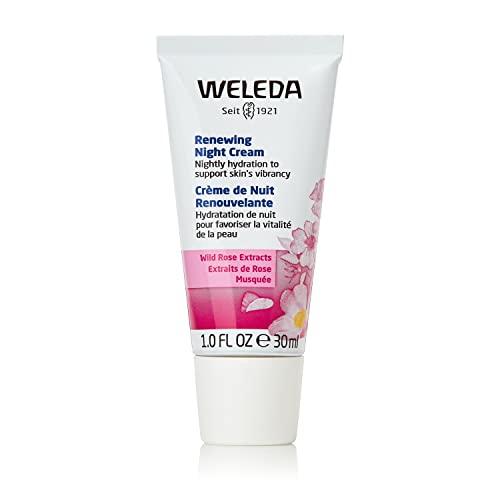
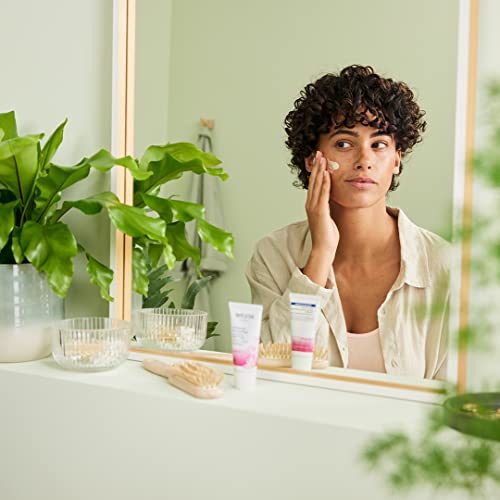
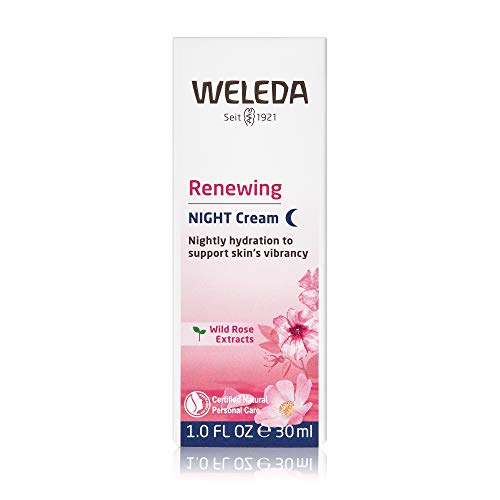
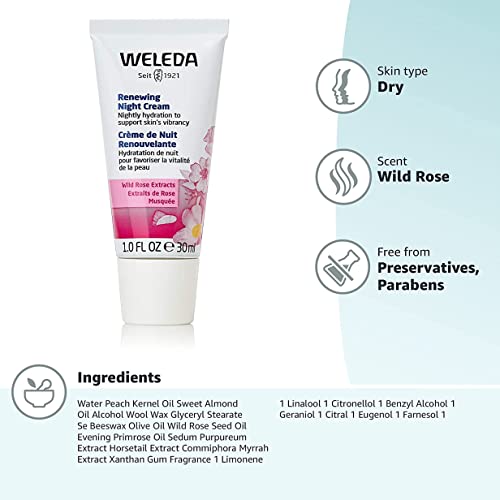


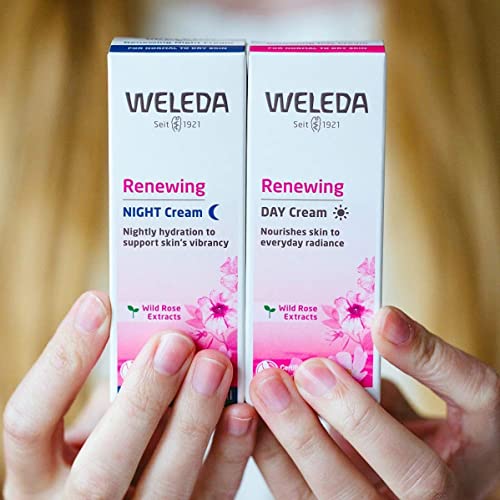
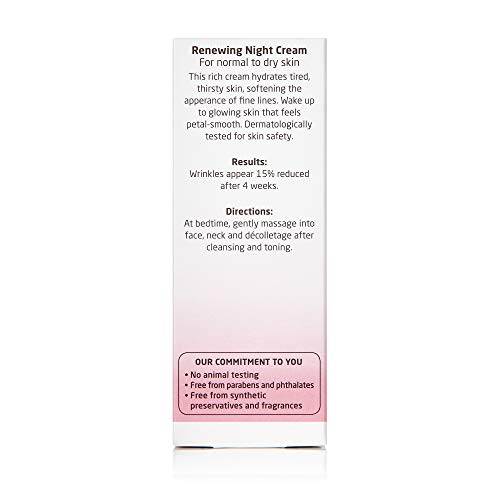
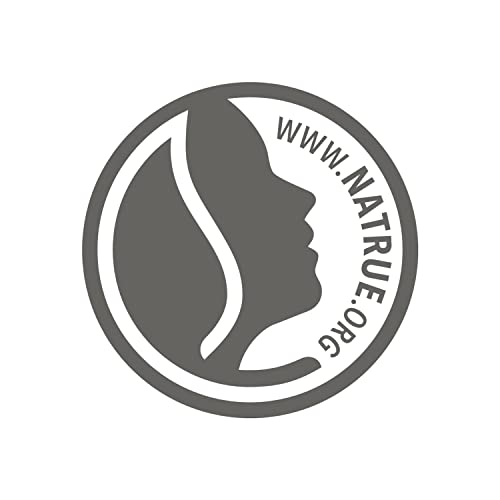

Weleda Night Face Cream - Hydrating Wild Rose & Almond Oils, 1oz Tube for Radiant Skin


Citral
High RiskCitral is a naturally occurring scent ingredient primarily used for its lemon-like fragrance in various products, including perfumes, cosmetics, and food. It is derived from essential oils such as lemon myrtle and lemongrass.
Sustai Insights
Citral offers functional benefits as a fragrance component, enhancing product appeal. However, it is associated with a high risk of allergy and irritation, particularly affecting the skin, eyes, and respiratory system. While its carcinogenicity and reproductive toxicity concerns are low, citral's environmental impact as a potential irritant raises caution. Regulatory bodies note usage restrictions due to its allergenic potential, leading to an overall high-risk assessment. Safe practices include patch testing for allergies, and alternatives such as synthetic fragrances may offer lower irritation risks.
Geraniol
High RiskGeraniol is a naturally occurring scent ingredient commonly found in essential oils from plants such as geraniums and lemongrass. It is primarily used for its pleasant floral aroma in perfumes, cosmetics, and household products.
Sustai Insights
Geraniol serves as a fragrance component and offers a natural option for scenting products. However, it has a high allergenic potential and may cause skin irritation in sensitive individuals. While it is considered low risk for carcinogenicity and reproductive toxicity, regulatory bodies have placed restrictions on its use due to allergenic concerns. Overall, the assessment reflects a high-risk level, particularly for those prone to allergies, highlighting the need for caution in its application.
Eugenol
High RiskEugenol is a naturally occurring scent chemical found in various plants, particularly clove oil, and is commonly used in fragrances, flavorings, and as a potential antimicrobial agent in personal care products. It is recognized for its aromatic properties and is utilized for its ability to mask undesirable odors.
Sustai Insights
Eugenol offers functional benefits as a fragrance and has potential antimicrobial properties, being biodegradable and derived from renewable sources. However, it poses high allergenic potential, irritation risks, and may affect sensitive individuals. Regulatory bodies have noted usage restrictions due to its health risks. Overall, eugenol is assessed to have a high risk level, making careful usage and consideration of alternatives advisable.
Citronellol
High RiskCitronellol is a naturally occurring scent ingredient commonly found in various essential oils. It is primarily used for its aromatic properties in perfumes, cosmetics, and household products, contributing to fragrance profiles.
Sustai Insights
Citronellol serves as a fragrance component, enhancing product appeal. However, it has a high allergenic potential, posing risks of skin irritation and sensitization. Environmental concerns include contamination risks. Regulatory bodies have restrictions on its use, emphasizing caution. Overall, citronellol presents a high risk regarding health and safety, warranting careful consideration in product formulations.
Farnesol
High RiskFarnesol is a flavor and perfume ingredient found in various cosmetic and personal care products. It is primarily used for its scent and potential antimicrobial properties, contributing to the overall fragrance profile of formulations.
Sustai Insights
Farnesol offers functional benefits as a fragrance component, but it raises significant health concerns, particularly its high allergenic potential. Regulatory bodies have imposed restrictions on its usage due to these risks. Environmentally, it poses risks as a potential pollutant, though it is not classified as bioaccumulative. Overall, the risk level associated with farnesol is high, necessitating careful consideration in product formulation and use. Alternatives such as natural essential oils may provide safer options.
Linalool
High RiskLinalool is a terpene commonly found in various plants, particularly in lavender and mint. It is primarily used in products for its fragrance and potential antimicrobial properties. Linalool is also utilized in formulations for its ability to enhance the sensory experience of personal care and household products.
Sustai Insights
Linalool offers functional benefits as a naturally occurring fragrance component and may exhibit antimicrobial properties. However, it presents high allergenic potential, with concerns about skin irritation and sensitization. Environmental risks include contamination issues, though it is not classified as a persistent pollutant. Regulatory bodies have noted the need for careful handling due to its allergenic nature. Overall, despite some beneficial attributes, the ingredient carries a high risk profile, warranting cautious use and consideration of safer alternatives.
Fragrance
High RiskFragrance refers to a mixture of aromatic compounds used in products to provide scent. It is commonly listed as 'fragrance' or 'parfum' on product labels and can serve various functions, including enhancing user experience and masking undesirable odors.
Sustai Insights
Fragrance offers functional benefits by improving product appeal; however, it poses significant health risks, notably a high likelihood of causing allergies and allergic contact dermatitis. Environmental risks include potential pollution and endocrine disruption, though its overall carcinogenicity is low. Regulatory bodies have noted concerns regarding its use, leading to a high-risk classification. Safe usage practices should be observed, and alternatives such as natural essential oils are recommended for those sensitive to synthetic fragrances.
Benzyl Alcohol
High RiskBenzyl alcohol is a naturally occurring and synthetic aromatic alcohol commonly used as a solvent, preservative, and fragrance ingredient in various products. It is found in both plant sources and as a synthetic compound, functioning primarily to maintain product stability and enhance fragrance profiles.
Sustai Insights
Benzyl alcohol serves effectively as a preservative and solvent, contributing to product stability and sensory qualities. However, it poses potential health risks, particularly as an allergen, with high concern for immunotoxicity. Environmental risks include being a pollutant with low bioaccumulation potential. Regulatory agencies have established restrictions on its use in certain products. Overall, the risk level associated with benzyl alcohol is assessed as high, necessitating careful consideration of its use and potential alternatives.
Limonene
Medium RiskLimonene is a scent ingredient and solvent naturally found in citrus fruits, commonly used in personal care and cleaning products for its fragrant properties. It serves as a flavoring agent and enhances the overall sensory experience of products.
Sustai Insights
Limonene offers functional benefits such as acting as a solvent and fragrance enhancer. However, it carries a high allergenic potential, which can trigger skin or respiratory sensitivities in some individuals. Environmental concerns include moderate persistence and bioaccumulation, along with potential ecotoxicity. Regulatory restrictions necessitate verification in products containing this ingredient. Overall, the risk level is assessed as medium, emphasizing the importance of cautious use, particularly for sensitive populations. Safer alternatives may be considered to mitigate these risks.
Glyceryl Stearate Se
Low RiskGlyceryl stearate SE is a self-emulsifying ingredient commonly used in cosmetic formulations to stabilize and thicken products. It acts as an emulsifier, helping to blend oil and water components effectively, which enhances the product's texture and stability.
Sustai Insights
Glyceryl stearate SE offers functional benefits as an emulsifier, promoting stability in formulations. It is considered low risk for health concerns, including cancer, allergies, and reproductive toxicity, with no significant environmental hazards reported. Regulatory bodies have not imposed restrictions on its use. Safe usage practices suggest following recommended concentrations in products. Overall, this ingredient is assessed as low risk, with no immediate alternatives needed.
Equisetum Arvense (Horsetail) Extract
Low RiskEquisetum arvense extract is derived from the horsetail plant, known for its high silica content. It is commonly used in cosmetic formulations for its potential benefits in promoting healthy skin and hair, as well as its role as a natural preservative due to its antioxidant properties.
Sustai Insights
Equisetum arvense extract offers functional benefits including enhancing skin and hair health through its silica content and antioxidant properties. It is sustainably sourced and biodegradable. Health risks are minimal, with low concerns for carcinogenicity, allergies, and reproductive toxicity. Environmental risks are also low, with no significant pollutant or bioaccumulative effects noted. Regulatory bodies do not list this ingredient as restricted. Overall, the risk level is assessed as low, making it a safe option in cosmetic products.
Prunus Persica (Peach) Kernel Oil
Low RiskPrunus persica (peach) kernel oil is an oil extracted from the seeds of the peach fruit. It is commonly used in cosmetic formulations for its moisturizing properties and as a carrier oil in various personal care products.
Sustai Insights
Prunus persica (peach) kernel oil offers functional benefits as an emollient, enhancing skin hydration and softness. It is sustainably sourced and considered biodegradable. Health risks are minimal, with low concerns regarding carcinogenicity, allergies, and reproductive toxicity. Environmental impact is low, with no significant pollutant or bioaccumulative properties reported. Regulatory agencies have not issued any significant warnings or restrictions. Usage recommendations include maintaining appropriate concentration levels in formulations. Overall, the risk associated with this ingredient is low, making it a suitable option in cosmetic applications.
Commiphora Myrrha (Myrrh) Resin Extract
Low RiskCommiphora myrrha (myrrh) resin extract is derived from the resin of the myrrh tree. It is commonly used in cosmetics and personal care products for its aromatic properties and potential skin benefits. Myrrh has historical significance in traditional medicine and is recognized for its role in fragrance formulations.
Sustai Insights
Myrrh extract is noted for its functional benefits, including antimicrobial properties and potential skin soothing effects. It is sustainably sourced and biodegradable. Health risks are minimal, with low concerns regarding carcinogenicity, allergies, and reproductive toxicity. Environmental risks are low, with no significant pollutants or bioaccumulation reported. Regulatory status is clear, with no current restrictions. Overall, the risk assessment for myrrh extract indicates a low risk, making it a safe option in product formulations. Safe usage practices should be followed, and alternatives include other natural resins if needed.
Sedum Purpureum Extract
Low RiskSedum purpureum extract is derived from the Sedum purpureum plant, primarily known for its use in cosmetic formulations. It is often included for its potential moisturizing and soothing properties, contributing to the overall texture and efficacy of personal care products.
Sustai Insights
Sedum purpureum extract offers functional benefits as a moisturizing agent, supporting skin hydration. It is considered low risk for adverse health effects, including carcinogenicity, allergies, and reproductive toxicity. Environmentally, it shows low pollutant potential and is not known to bioaccumulate. Regulatory bodies have not placed any restrictions on its use, affirming its safety. Overall, the ingredient is assessed to have a low risk profile, making it a viable option in formulations with minimal safety concerns.
Anhydrous Liquid Lanolin
Low RiskAnhydrous liquid lanolin is a refined derivative of the fat-like substance secreted by sheep's wool. It serves primarily as a moisturizer and emollient in various cosmetic and personal care products, providing a protective barrier to the skin.
Sustai Insights
Anhydrous liquid lanolin offers functional benefits as a moisturizer, helping to maintain skin hydration and barrier function. It is generally regarded as low risk for cancer, developmental toxicity, and use restrictions, though it may pose low to moderate allergenic risks for sensitive individuals. Environmentally, it is not considered a significant pollutant or bioaccumulative. Regulatory assessments confirm its safety within established limits. For those with allergies, alternatives like plant-based oils may be considered. Overall, the risk associated with this ingredient is low.
Anhydrous Liquid Lanolin
Low RiskAnhydrous liquid lanolin is a refined derivative of the fat-like substance secreted by sheep's wool. It serves primarily as a moisturizer and emollient in various cosmetic and personal care products, providing a protective barrier to the skin.
Sustai Insights
Anhydrous liquid lanolin offers functional benefits as a moisturizer, helping to maintain skin hydration and barrier function. It is generally regarded as low risk for cancer, developmental toxicity, and use restrictions, though it may pose low to moderate allergenic risks for sensitive individuals. Environmentally, it is not considered a significant pollutant or bioaccumulative. Regulatory assessments confirm its safety within established limits. For those with allergies, alternatives like plant-based oils may be considered. Overall, the risk associated with this ingredient is low.
Oenothera Biennis (Evening Primrose) Oil
Low RiskEvening primrose oil is extracted from Oenothera biennis seeds and is commonly used in cosmetic formulations for its moisturizing properties. It contains gamma-linolenic acid (GLA), which is believed to support skin health and improve hydration.
Sustai Insights
Evening primrose oil offers functional benefits as a moisturizer and skin soother, derived from sustainably sourced seeds, contributing to its appeal. Health risks are low, with negligible concerns regarding carcinogenicity, allergies, and reproductive toxicity. Environmental assessments indicate no significant pollutants or bioaccumulation potential. Regulatory bodies do not impose restrictions on its use. Overall, the risk level is low, making it a suitable choice for cosmetic applications. Safe usage practices should be followed, although alternatives like borage oil may provide similar benefits.
Olea Europaea (Olive) Oil
Low RiskOlea europaea (olive) oil is derived from the ripe fruit of the olive tree. It is commonly used in cosmetic formulations primarily as a moisturizer and emollient due to its nourishing properties for the skin. It also serves as a carrier oil for other ingredients in formulations.
Sustai Insights
Olea europaea (olive) oil offers numerous functional benefits, including effective moisturization and enhanced skin absorption properties, making it suitable for various cosmetic applications. It is a biodegradable ingredient, contributing to sustainability when sourced responsibly. Health risks are low, with minimal concerns regarding carcinogenicity, allergenic potential, and developmental toxicity. Environmental risks are also low, with no significant bioaccumulation or pollution potential noted. Regulatory bodies do not impose restrictions on its use. Overall, olive oil presents a low risk profile, making it a favorable choice in cosmetic products.
Ethanol
Low RiskEthanol, also known as ethyl alcohol, is a volatile, colorless liquid commonly used as a solvent, preservative, and antiseptic in various personal care products. It serves as a penetration enhancer, improving the absorption of other ingredients through the skin.
Sustai Insights
Ethanol functions effectively as a preservative and solvent, offering benefits such as enhanced ingredient absorption and antimicrobial properties. It is biodegradable and can be sustainably sourced. Health risks are minimal, with low concerns for carcinogenicity, allergies, and developmental toxicity. Environmental impacts are also low, with no significant pollutant potential. Regulatory agencies do not impose restrictions on its use. Overall, ethanol is considered low risk, making it a widely accepted ingredient in personal care formulations.
Beeswax
Low RiskBeeswax is the purified wax obtained from the honeycomb of honeybees. It is typically used as a thickening agent, emulsifier, or to provide structure in various cosmetic and personal care products.
Sustai Insights
Beeswax offers functional benefits as a natural emulsifier and thickening agent, contributing to product stability and texture. It is biodegradable and sustainably sourced, aligning with eco-friendly practices. Health risks are low, with minimal concerns regarding carcinogenicity, allergies, or irritation. Environmental risks are also low, with no significant pollutant or bioaccumulation issues. Regulatory bodies impose few restrictions, confirming its safety in use. Safe usage practices should be followed, and alternatives like plant-based waxes may be considered for those seeking vegan options. Overall, the risk level associated with beeswax is low.
Prunus Amygdalus Dulcis (Sweet Almond) Oil
Low RiskPrunus amygdalus dulcis (sweet almond) oil is derived from the seeds of the almond tree. It is commonly used in cosmetic formulations for its moisturizing properties and as a carrier oil for other active ingredients. Its light texture allows for easy absorption into the skin.
Sustai Insights
Sweet almond oil provides functional benefits such as effective skin hydration and enhancement of skin absorption for other compounds. It is sustainably sourced and biodegradable. Health risks are low, with minimal concerns regarding carcinogenicity, allergies, and reproductive toxicity. Environmental risks are also low, with no significant pollutant or bioaccumulation potential. Regulatory bodies currently do not impose restrictions on its use. Overall, the risk assessment indicates a low risk level, making it a safe choice in cosmetic applications.
Rosa Moschata (Musk Rose) Seed Oil
Low RiskRosa moschata (musk rose) seed oil is an oil expressed from the seeds of the musk rose plant. It is commonly used in cosmetic formulations for its moisturizing properties and potential skin benefits.
Sustai Insights
Rosa moschata seed oil offers functional benefits such as moisturizing and skin-rejuvenating properties, making it suitable for various cosmetic applications. It is sustainably sourced and considered biodegradable. Health risks associated with this ingredient are low, with minimal concerns regarding carcinogenicity, allergies, or reproductive toxicity. Environmental risks are also low, as it does not contribute significantly to pollution or bioaccumulation. Regulatory assessments indicate no major advisories on its use. Overall risk level is low, with safe usage practices recommended; alternatives include other plant-based oils like jojoba or argan oil.
Water
Low RiskWater is a clear, colorless liquid essential for various biological processes. It serves as a solvent in formulations, facilitating the dissolution of other ingredients and enhancing product texture and application. Additionally, water plays a crucial role in hydration and is a key component in many cosmetic and personal care products.
Sustai Insights
Water is an effective solvent and hydrator, contributing to the texture and efficacy of formulations. It is biodegradable and generally regarded as safe, with low concerns regarding carcinogenicity, allergies, and reproductive toxicity. However, excessive water usage can lead to environmental concerns, particularly regarding resource depletion. Regulatory bodies do not impose restrictions on water use in cosmetics. Overall, the risks associated with water are low, making it a safe and essential ingredient.
Xanthan Gum
Low RiskXanthan gum is a polysaccharide, a sugar-based compound produced by the fermentation of glucose or sucrose. It is commonly used as a thickening agent and stabilizer in various food and cosmetic products due to its ability to improve texture and prevent ingredient separation.
Sustai Insights
Xanthan gum serves effectively as a thickener and stabilizer, enhancing product texture and consistency. It is biodegradable and typically derived from renewable sources, supporting sustainability efforts. Health risks are minimal, with low concerns regarding carcinogenicity, allergies, and reproductive toxicity. Environmental impact is similarly low, posing no significant hazards. Regulatory agencies, including the FDA, regard it as safe for use, with no significant restrictions. Overall, xanthan gum is assessed as low risk, making it a suitable ingredient in formulations.
Glyceryl Stearate Se
Low RiskGlyceryl stearate SE is a self-emulsifying ingredient commonly used in cosmetic formulations to stabilize and thicken products. It acts as an emulsifier, helping to blend oil and water components effectively, which enhances the product's texture and stability.
Sustai Insights
Glyceryl stearate SE offers functional benefits as an emulsifier, promoting stability in formulations. It is considered low risk for health concerns, including cancer, allergies, and reproductive toxicity, with no significant environmental hazards reported. Regulatory bodies have not imposed restrictions on its use. Safe usage practices suggest following recommended concentrations in products. Overall, this ingredient is assessed as low risk, with no immediate alternatives needed.
Equisetum Arvense (Horsetail) Extract
Low RiskEquisetum arvense extract is derived from the horsetail plant, known for its high silica content. It is commonly used in cosmetic formulations for its potential benefits in promoting healthy skin and hair, as well as its role as a natural preservative due to its antioxidant properties.
Sustai Insights
Equisetum arvense extract offers functional benefits including enhancing skin and hair health through its silica content and antioxidant properties. It is sustainably sourced and biodegradable. Health risks are minimal, with low concerns for carcinogenicity, allergies, and reproductive toxicity. Environmental risks are also low, with no significant pollutant or bioaccumulative effects noted. Regulatory bodies do not list this ingredient as restricted. Overall, the risk level is assessed as low, making it a safe option in cosmetic products.
Citral
High RiskCitral is a naturally occurring scent ingredient primarily used for its lemon-like fragrance in various products, including perfumes, cosmetics, and food. It is derived from essential oils such as lemon myrtle and lemongrass.
Sustai Insights
Citral offers functional benefits as a fragrance component, enhancing product appeal. However, it is associated with a high risk of allergy and irritation, particularly affecting the skin, eyes, and respiratory system. While its carcinogenicity and reproductive toxicity concerns are low, citral's environmental impact as a potential irritant raises caution. Regulatory bodies note usage restrictions due to its allergenic potential, leading to an overall high-risk assessment. Safe practices include patch testing for allergies, and alternatives such as synthetic fragrances may offer lower irritation risks.
Geraniol
High RiskGeraniol is a naturally occurring scent ingredient commonly found in essential oils from plants such as geraniums and lemongrass. It is primarily used for its pleasant floral aroma in perfumes, cosmetics, and household products.
Sustai Insights
Geraniol serves as a fragrance component and offers a natural option for scenting products. However, it has a high allergenic potential and may cause skin irritation in sensitive individuals. While it is considered low risk for carcinogenicity and reproductive toxicity, regulatory bodies have placed restrictions on its use due to allergenic concerns. Overall, the assessment reflects a high-risk level, particularly for those prone to allergies, highlighting the need for caution in its application.
Eugenol
High RiskEugenol is a naturally occurring scent chemical found in various plants, particularly clove oil, and is commonly used in fragrances, flavorings, and as a potential antimicrobial agent in personal care products. It is recognized for its aromatic properties and is utilized for its ability to mask undesirable odors.
Sustai Insights
Eugenol offers functional benefits as a fragrance and has potential antimicrobial properties, being biodegradable and derived from renewable sources. However, it poses high allergenic potential, irritation risks, and may affect sensitive individuals. Regulatory bodies have noted usage restrictions due to its health risks. Overall, eugenol is assessed to have a high risk level, making careful usage and consideration of alternatives advisable.
Prunus Persica (Peach) Kernel Oil
Low RiskPrunus persica (peach) kernel oil is an oil extracted from the seeds of the peach fruit. It is commonly used in cosmetic formulations for its moisturizing properties and as a carrier oil in various personal care products.
Sustai Insights
Prunus persica (peach) kernel oil offers functional benefits as an emollient, enhancing skin hydration and softness. It is sustainably sourced and considered biodegradable. Health risks are minimal, with low concerns regarding carcinogenicity, allergies, and reproductive toxicity. Environmental impact is low, with no significant pollutant or bioaccumulative properties reported. Regulatory agencies have not issued any significant warnings or restrictions. Usage recommendations include maintaining appropriate concentration levels in formulations. Overall, the risk associated with this ingredient is low, making it a suitable option in cosmetic applications.
Commiphora Myrrha (Myrrh) Resin Extract
Low RiskCommiphora myrrha (myrrh) resin extract is derived from the resin of the myrrh tree. It is commonly used in cosmetics and personal care products for its aromatic properties and potential skin benefits. Myrrh has historical significance in traditional medicine and is recognized for its role in fragrance formulations.
Sustai Insights
Myrrh extract is noted for its functional benefits, including antimicrobial properties and potential skin soothing effects. It is sustainably sourced and biodegradable. Health risks are minimal, with low concerns regarding carcinogenicity, allergies, and reproductive toxicity. Environmental risks are low, with no significant pollutants or bioaccumulation reported. Regulatory status is clear, with no current restrictions. Overall, the risk assessment for myrrh extract indicates a low risk, making it a safe option in product formulations. Safe usage practices should be followed, and alternatives include other natural resins if needed.
Sedum Purpureum Extract
Low RiskSedum purpureum extract is derived from the Sedum purpureum plant, primarily known for its use in cosmetic formulations. It is often included for its potential moisturizing and soothing properties, contributing to the overall texture and efficacy of personal care products.
Sustai Insights
Sedum purpureum extract offers functional benefits as a moisturizing agent, supporting skin hydration. It is considered low risk for adverse health effects, including carcinogenicity, allergies, and reproductive toxicity. Environmentally, it shows low pollutant potential and is not known to bioaccumulate. Regulatory bodies have not placed any restrictions on its use, affirming its safety. Overall, the ingredient is assessed to have a low risk profile, making it a viable option in formulations with minimal safety concerns.
Citronellol
High RiskCitronellol is a naturally occurring scent ingredient commonly found in various essential oils. It is primarily used for its aromatic properties in perfumes, cosmetics, and household products, contributing to fragrance profiles.
Sustai Insights
Citronellol serves as a fragrance component, enhancing product appeal. However, it has a high allergenic potential, posing risks of skin irritation and sensitization. Environmental concerns include contamination risks. Regulatory bodies have restrictions on its use, emphasizing caution. Overall, citronellol presents a high risk regarding health and safety, warranting careful consideration in product formulations.
Anhydrous Liquid Lanolin
Low RiskAnhydrous liquid lanolin is a refined derivative of the fat-like substance secreted by sheep's wool. It serves primarily as a moisturizer and emollient in various cosmetic and personal care products, providing a protective barrier to the skin.
Sustai Insights
Anhydrous liquid lanolin offers functional benefits as a moisturizer, helping to maintain skin hydration and barrier function. It is generally regarded as low risk for cancer, developmental toxicity, and use restrictions, though it may pose low to moderate allergenic risks for sensitive individuals. Environmentally, it is not considered a significant pollutant or bioaccumulative. Regulatory assessments confirm its safety within established limits. For those with allergies, alternatives like plant-based oils may be considered. Overall, the risk associated with this ingredient is low.
Anhydrous Liquid Lanolin
Low RiskAnhydrous liquid lanolin is a refined derivative of the fat-like substance secreted by sheep's wool. It serves primarily as a moisturizer and emollient in various cosmetic and personal care products, providing a protective barrier to the skin.
Sustai Insights
Anhydrous liquid lanolin offers functional benefits as a moisturizer, helping to maintain skin hydration and barrier function. It is generally regarded as low risk for cancer, developmental toxicity, and use restrictions, though it may pose low to moderate allergenic risks for sensitive individuals. Environmentally, it is not considered a significant pollutant or bioaccumulative. Regulatory assessments confirm its safety within established limits. For those with allergies, alternatives like plant-based oils may be considered. Overall, the risk associated with this ingredient is low.
Oenothera Biennis (Evening Primrose) Oil
Low RiskEvening primrose oil is extracted from Oenothera biennis seeds and is commonly used in cosmetic formulations for its moisturizing properties. It contains gamma-linolenic acid (GLA), which is believed to support skin health and improve hydration.
Sustai Insights
Evening primrose oil offers functional benefits as a moisturizer and skin soother, derived from sustainably sourced seeds, contributing to its appeal. Health risks are low, with negligible concerns regarding carcinogenicity, allergies, and reproductive toxicity. Environmental assessments indicate no significant pollutants or bioaccumulation potential. Regulatory bodies do not impose restrictions on its use. Overall, the risk level is low, making it a suitable choice for cosmetic applications. Safe usage practices should be followed, although alternatives like borage oil may provide similar benefits.
Farnesol
High RiskFarnesol is a flavor and perfume ingredient found in various cosmetic and personal care products. It is primarily used for its scent and potential antimicrobial properties, contributing to the overall fragrance profile of formulations.
Sustai Insights
Farnesol offers functional benefits as a fragrance component, but it raises significant health concerns, particularly its high allergenic potential. Regulatory bodies have imposed restrictions on its usage due to these risks. Environmentally, it poses risks as a potential pollutant, though it is not classified as bioaccumulative. Overall, the risk level associated with farnesol is high, necessitating careful consideration in product formulation and use. Alternatives such as natural essential oils may provide safer options.
Olea Europaea (Olive) Oil
Low RiskOlea europaea (olive) oil is derived from the ripe fruit of the olive tree. It is commonly used in cosmetic formulations primarily as a moisturizer and emollient due to its nourishing properties for the skin. It also serves as a carrier oil for other ingredients in formulations.
Sustai Insights
Olea europaea (olive) oil offers numerous functional benefits, including effective moisturization and enhanced skin absorption properties, making it suitable for various cosmetic applications. It is a biodegradable ingredient, contributing to sustainability when sourced responsibly. Health risks are low, with minimal concerns regarding carcinogenicity, allergenic potential, and developmental toxicity. Environmental risks are also low, with no significant bioaccumulation or pollution potential noted. Regulatory bodies do not impose restrictions on its use. Overall, olive oil presents a low risk profile, making it a favorable choice in cosmetic products.
Ethanol
Low RiskEthanol, also known as ethyl alcohol, is a volatile, colorless liquid commonly used as a solvent, preservative, and antiseptic in various personal care products. It serves as a penetration enhancer, improving the absorption of other ingredients through the skin.
Sustai Insights
Ethanol functions effectively as a preservative and solvent, offering benefits such as enhanced ingredient absorption and antimicrobial properties. It is biodegradable and can be sustainably sourced. Health risks are minimal, with low concerns for carcinogenicity, allergies, and developmental toxicity. Environmental impacts are also low, with no significant pollutant potential. Regulatory agencies do not impose restrictions on its use. Overall, ethanol is considered low risk, making it a widely accepted ingredient in personal care formulations.
Beeswax
Low RiskBeeswax is the purified wax obtained from the honeycomb of honeybees. It is typically used as a thickening agent, emulsifier, or to provide structure in various cosmetic and personal care products.
Sustai Insights
Beeswax offers functional benefits as a natural emulsifier and thickening agent, contributing to product stability and texture. It is biodegradable and sustainably sourced, aligning with eco-friendly practices. Health risks are low, with minimal concerns regarding carcinogenicity, allergies, or irritation. Environmental risks are also low, with no significant pollutant or bioaccumulation issues. Regulatory bodies impose few restrictions, confirming its safety in use. Safe usage practices should be followed, and alternatives like plant-based waxes may be considered for those seeking vegan options. Overall, the risk level associated with beeswax is low.
Prunus Amygdalus Dulcis (Sweet Almond) Oil
Low RiskPrunus amygdalus dulcis (sweet almond) oil is derived from the seeds of the almond tree. It is commonly used in cosmetic formulations for its moisturizing properties and as a carrier oil for other active ingredients. Its light texture allows for easy absorption into the skin.
Sustai Insights
Sweet almond oil provides functional benefits such as effective skin hydration and enhancement of skin absorption for other compounds. It is sustainably sourced and biodegradable. Health risks are low, with minimal concerns regarding carcinogenicity, allergies, and reproductive toxicity. Environmental risks are also low, with no significant pollutant or bioaccumulation potential. Regulatory bodies currently do not impose restrictions on its use. Overall, the risk assessment indicates a low risk level, making it a safe choice in cosmetic applications.
Rosa Moschata (Musk Rose) Seed Oil
Low RiskRosa moschata (musk rose) seed oil is an oil expressed from the seeds of the musk rose plant. It is commonly used in cosmetic formulations for its moisturizing properties and potential skin benefits.
Sustai Insights
Rosa moschata seed oil offers functional benefits such as moisturizing and skin-rejuvenating properties, making it suitable for various cosmetic applications. It is sustainably sourced and considered biodegradable. Health risks associated with this ingredient are low, with minimal concerns regarding carcinogenicity, allergies, or reproductive toxicity. Environmental risks are also low, as it does not contribute significantly to pollution or bioaccumulation. Regulatory assessments indicate no major advisories on its use. Overall risk level is low, with safe usage practices recommended; alternatives include other plant-based oils like jojoba or argan oil.
Water
Low RiskWater is a clear, colorless liquid essential for various biological processes. It serves as a solvent in formulations, facilitating the dissolution of other ingredients and enhancing product texture and application. Additionally, water plays a crucial role in hydration and is a key component in many cosmetic and personal care products.
Sustai Insights
Water is an effective solvent and hydrator, contributing to the texture and efficacy of formulations. It is biodegradable and generally regarded as safe, with low concerns regarding carcinogenicity, allergies, and reproductive toxicity. However, excessive water usage can lead to environmental concerns, particularly regarding resource depletion. Regulatory bodies do not impose restrictions on water use in cosmetics. Overall, the risks associated with water are low, making it a safe and essential ingredient.
Limonene
Medium RiskLimonene is a scent ingredient and solvent naturally found in citrus fruits, commonly used in personal care and cleaning products for its fragrant properties. It serves as a flavoring agent and enhances the overall sensory experience of products.
Sustai Insights
Limonene offers functional benefits such as acting as a solvent and fragrance enhancer. However, it carries a high allergenic potential, which can trigger skin or respiratory sensitivities in some individuals. Environmental concerns include moderate persistence and bioaccumulation, along with potential ecotoxicity. Regulatory restrictions necessitate verification in products containing this ingredient. Overall, the risk level is assessed as medium, emphasizing the importance of cautious use, particularly for sensitive populations. Safer alternatives may be considered to mitigate these risks.
Linalool
High RiskLinalool is a terpene commonly found in various plants, particularly in lavender and mint. It is primarily used in products for its fragrance and potential antimicrobial properties. Linalool is also utilized in formulations for its ability to enhance the sensory experience of personal care and household products.
Sustai Insights
Linalool offers functional benefits as a naturally occurring fragrance component and may exhibit antimicrobial properties. However, it presents high allergenic potential, with concerns about skin irritation and sensitization. Environmental risks include contamination issues, though it is not classified as a persistent pollutant. Regulatory bodies have noted the need for careful handling due to its allergenic nature. Overall, despite some beneficial attributes, the ingredient carries a high risk profile, warranting cautious use and consideration of safer alternatives.
Fragrance
High RiskFragrance refers to a mixture of aromatic compounds used in products to provide scent. It is commonly listed as 'fragrance' or 'parfum' on product labels and can serve various functions, including enhancing user experience and masking undesirable odors.
Sustai Insights
Fragrance offers functional benefits by improving product appeal; however, it poses significant health risks, notably a high likelihood of causing allergies and allergic contact dermatitis. Environmental risks include potential pollution and endocrine disruption, though its overall carcinogenicity is low. Regulatory bodies have noted concerns regarding its use, leading to a high-risk classification. Safe usage practices should be observed, and alternatives such as natural essential oils are recommended for those sensitive to synthetic fragrances.
Xanthan Gum
Low RiskXanthan gum is a polysaccharide, a sugar-based compound produced by the fermentation of glucose or sucrose. It is commonly used as a thickening agent and stabilizer in various food and cosmetic products due to its ability to improve texture and prevent ingredient separation.
Sustai Insights
Xanthan gum serves effectively as a thickener and stabilizer, enhancing product texture and consistency. It is biodegradable and typically derived from renewable sources, supporting sustainability efforts. Health risks are minimal, with low concerns regarding carcinogenicity, allergies, and reproductive toxicity. Environmental impact is similarly low, posing no significant hazards. Regulatory agencies, including the FDA, regard it as safe for use, with no significant restrictions. Overall, xanthan gum is assessed as low risk, making it a suitable ingredient in formulations.
Benzyl Alcohol
High RiskBenzyl alcohol is a naturally occurring and synthetic aromatic alcohol commonly used as a solvent, preservative, and fragrance ingredient in various products. It is found in both plant sources and as a synthetic compound, functioning primarily to maintain product stability and enhance fragrance profiles.
Sustai Insights
Benzyl alcohol serves effectively as a preservative and solvent, contributing to product stability and sensory qualities. However, it poses potential health risks, particularly as an allergen, with high concern for immunotoxicity. Environmental risks include being a pollutant with low bioaccumulation potential. Regulatory agencies have established restrictions on its use in certain products. Overall, the risk level associated with benzyl alcohol is assessed as high, necessitating careful consideration of its use and potential alternatives.
Discover the Weleda Renewing Night Face Cream, a luxurious plant-rich moisturizer designed to rejuvenate your skin while you sleep. Infused with wild rose, peach kernel, and sweet almond oils, this cream works overnight to soften fine lines and hydrate your complexion for a radiant glow.
- Nourishing Hydration: Wild rose oil helps to smooth and hydrate, leaving skin refreshed and soft by morning.
- Natural Ingredients: Crafted with flower, fruit, and root extracts, free from synthetic compounds, ensuring a gentle touch for your skin.
- Mindful Skincare: Rich in plant oils, it not only nourishes your skin but also calms your mind, providing an overall sense of well-being.
- Easy Application: Simply cleanse your face, apply the cream, and let it work overnight for optimal results.
- Ethical Practices: Weleda is committed to sustainable sourcing and ethical production, making it a choice you can feel good about.
Experience the harmony of nature and skincare with Weleda's Renewing Night Face Cream for a revived, glowing complexion.
Subscribe & Save with Sustai
- Best Price Guarantee: Always enjoy the lowest prices on sustainable home essentials.
- No Surprises: We’ll notify you before shipping. No hidden fees, ever.
- You’re in Charge: Change, pause, or cancel your subscription anytime with ease.
- Eco-Friendly Deliveries: Our grouped shipments mean less packaging and lower emissions.
Join us on a sustainable journey. Special offers for a limited time! Prices and promotions may change.
Recommended Products
Discover the Weleda Renewing Night Face Cream, a luxurious plant-rich moisturizer designed to rejuvenate your skin while you sleep. Infused with wild rose, peach kernel, and sweet almond oils, this cream works overnight to soften fine lines and hydrate your complexion for a radiant glow.
- Nourishing Hydration: Wild rose oil helps to smooth and hydrate, leaving skin refreshed and soft by morning.
- Natural Ingredients: Crafted with flower, fruit, and root extracts, free from synthetic compounds, ensuring a gentle touch for your skin.
- Mindful Skincare: Rich in plant oils, it not only nourishes your skin but also calms your mind, providing an overall sense of well-being.
- Easy Application: Simply cleanse your face, apply the cream, and let it work overnight for optimal results.
- Ethical Practices: Weleda is committed to sustainable sourcing and ethical production, making it a choice you can feel good about.
Experience the harmony of nature and skincare with Weleda's Renewing Night Face Cream for a revived, glowing complexion.

You can have at most 2 Sustainable Steals products in your cart
Customer Reviews
Customers’ View
Customers appreciate the moisturizing properties and quality of the Night Face Cream, noting it leaves their skin feeling soft, silky, and well-hydrated. Many users highlight the natural ingredients, particularly the wild rose oil, which they find gentle and nourishing, aligning with their eco-friendly values. Some enjoy the scent, describing it as divine, while others have mixed feelings about its intensity. Feedback indicates that the cream is effective for various skin types, including sensitive and dry skin, contributing to a youthful glow. Overall, customers find this product effective and consistent with their commitment to natural skincare.
AI-generated from the text of customer reviewsThis product is rated 4.7 of 5.0 stars.
It has received 3 reviews.




